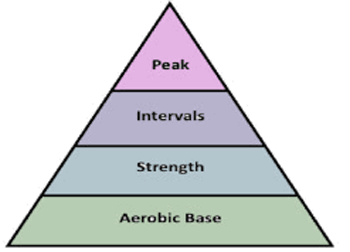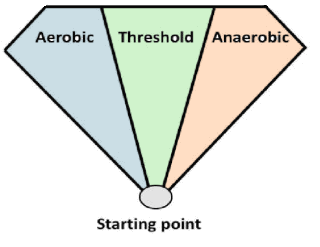Just like there are many ways to skin a cat, there are many ways to formulate the perfect training plan. The trick is finding that critical balance of workouts, recovery, and training paces that work for your body and your particular strengths and weaknesses.
The variety of different training approaches is one of the many reasons that we have a unique and diverse coaching staff here at RunnersConnect. Our different backgrounds and training philosophies allow us to easily find that perfect blend that works for your body and your goals. Even better, since our staff of coaches are on the cutting-edge, elite side of the sport, the training models we’re able to deliver to you are often revolutionary and represent innovative ways to help you make consistent progress.
One unique training model brought in by one of our coaches turns the whole idea of the training pyramid upside down – literally. Let’s take a more in-depth look at this training concept and how it can help make you faster:
The Traditional Training Model
The traditional training model, popularized by Authur Lydiard, is often called the pyramid model. The pyramid model is based on the idea that you begin with a large aerobic base, transition to strength work such tempo runs, add in speed work, and then peak at the end of the training cycle.
The most important and longest phase in this model is aerobic development, so it occupies the base of what looks like a pyramid. As each cycle progresses, you reduce overall volume and the total amount of running you do. Therefore, by the peak phase of the pyramid, you’re aerobic mileage and tempo work makes up very little of your overall training week.
If you’ve never seen the traditional model before, it looks something like this:

The benefit of the pyramid model is that you spend ample time in each training cycle working on aerobic development before adding in speed work. Aerobic development is universally considered the most important physiological adaptation to running faster long-term, so it’s important to spend time building your mileage base.
The argument against the pyramid
In recent years, the pyramid model has come under increasing scrutiny as elite athletes search for ever faster performances. As new training models emerged, cracks started to form at the base of the traditional pyramid model.
The main argument against the pyramid model is the notion that aerobic development, lactate threshold, and speed do not have to be trained independently of each other, i.e. you don’t have to run months of just mileage or taper off your tempo runs as you introduce speed work.
Second, when you train using the typical pyramid model, you’re forced to revert back to a base building period after each training cycle and you lose many of the of the strength and speed gains you’ve made at the top of the pyramid. Therefore, you spend a good portion of your next training cycle just trying to get back to that level of speed and strength, instead of constantly improving the current point that you’re at.
The New Training Model
Many elite coaches now believe that you can safely improve all these physiological elements within the same training cycle as long as you approach development in a progressive fashion.
This radical shift in thinking by the top minds in the sport has lead to a new model of training that develops your speed, aerobic endurance, and strength at the same time. This new model is often called the diamond training model.
The diamond training model is a system in which runners work to improve all aspects of training at the same time by starting at a low, fairly easy total training volume and slowly increase the total amount of work the complete each week.
Interestingly, the diamond model resembles an upside down pyramid:

The beauty of the diamond model is that each physiological training element is trained simultaneously at your current level of fitness. Each week you slowly build upon each component so that no particular energy system is left behind. You start at whatever fitness level you’re at and by the end of the training cycle, your aerobic development, speed, and threshold are at their maximum levels simultaneously, which leads to optimal performance on race day.
The Benefits of the Diamond Model
With the diamond model, you never get too far away from any one training component. With the traditional model, you may have weeks or months where you don’t run higher mileage or do tempo workouts. With the diamond model, you can place slightly more emphasis on speed when you’re training for a 5k or aerobic development when running the marathon, but the concept of the training model never allows you to neglect one training element for too long. This system has numerous potential benefits:
Racing more consistently
In the diamond model, because you’re never too far away from having done speed work or improving your lactate threshold, you can race more consistently in your tune-up races. While you won’t be at your ultimate peak fitness, the diamond model ensures that you can at least have all your systems running at full current capacity.
This is especially helpful for runners who have multiple goal races or who are building up to racing for the first time. The diamond model allows for noticeable progression from week-to-week and the opportunity to test yourself at multiple race distances.
Better development for older runners
For you older or more experienced runners, especially those of you who have generated significant gains in aerobic endurance thanks to years of running, the diamond model can help capitalize on your strengths while developing your weaknesses. How?
Since speed is one of the first training aspects to deteriorate as you age, the diamond model allows you to continually work on speed and make it a part of your weekly training cycle. Therefore, the deteriorations in ability are less dramatic and your overall race times will improve.
Less injuries
The main cause of running injuries, especially for beginners, is that often the muscles, tendons, and ligaments aren’t at the same fitness level as aerobic conditioning. Simply speaking, you’re able to run fast without breathing hard because you’re strong aerobically, but your muscles can’t keep up with the intense demands of running hard.
The diamond model reduces the occurrence of these types of injuries because you’re increasing your muscular strength and endurance at the same time as your aerobic capabilities. Therefore, you’re less likely to be able to push beyond what your body can handle and progressively build your tolerance for volume and speed.
The Right Training Model for You
Choosing the right training model and correct way to address your specific needs often requires a little trial and error as you learn what works for your body and what doesn’t. The optimal training philosophy for your running partner may or may not work for you, so it’s important to continually learn.
Moreover, you don’t need to adhere religiously to one training model. You can pick and choose the specific aspects of each training model or philosophy that work best for you. This is how many of our coaches approach training and coaching. We combine the vast amount of knowledge we’ve gathered over our careers training and coaching at the highest levels of the sport and create a unique philosophy for each athlete we coach.
If training philosophies seem harder than calculus, and figuring out how to solve the training plan puzzle on your own is daunting, we’re here to help you every step of the way. Sign-up for our online running coach service and we’ll work one-on-one with you to create the perfect plan. Or, you can start a free trial of for our basic membership and let us guide you step-by-step through the entire training process.
If you have any questions about training models, both new and old, leave a comment and we would be glad to help you solve the puzzle.





One Response
Good stuff.